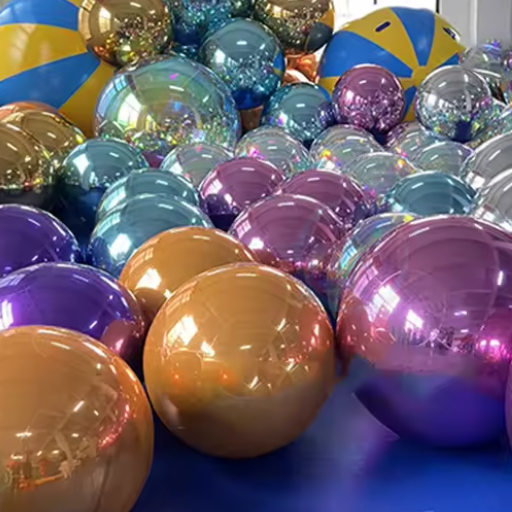Helium balloons are a must-have at parties, filling the air with happiness and color. Nevertheless, one of the most frequently asked questions during party preparations is, “How long will my helium balloons last?” The life span of helium balloons is a crucial factor for making sure that your decorations are at their best when the time comes. This article discusses what to consider when buying helium balloons, their longevity, and suggests tips from the experts on how to maximize their float time. It doesn’t matter if you are throwing a birthday party, wedding or any corporate event, we will provide you with the insights that will keep your balloons up in the air for the entire celebration!
Understanding Helium Balloons

A helium balloon’s life span is contingent upon several critical factors, the main ones being the balloon’s material and the environment around it. As far as I know, latex helium balloons generally float for around 8 to 12 hours, whereas the lifespan of foil balloons can stretch as long as several days or even weeks.
What Are Helium Balloons?
Helium balloons are those that contain helium gas which is a non-flammable lightweight gas that has a lower density than air. This property of helium allowing it to float is the reason why helium balloons are commonly used as decorations for parties, events, and celebrations. They are made mainly of latex or foil, and come in a wide range of different forms, colors, and sizes that can be chosen according to different occasions.
These balloons are very popular as they can be kept up in the sky for a longer time, with latex balloons generally floating for 8 to 12 hours and foil balloons lasting 4 to 24 hours, sometimes even up to a week, depending on their size and quality. Temperature, altitude, and humidity are a few of the factors that can influence their lifespan. For instance, helium balloons deflate quite quickly in hot places because of the gas’s constant expansion and contraction.
How Do Helium Balloons Work?
The operation of helium balloons is derived from the application of buoyancy and density principles. Helium is a very light gas, and it is an inert gas, its density is much lower than that of air which makes it possible for helium-filled objects to float. There is an upward force produced when a balloon is filled with helium gas since the gas inside the balloon pushes up the heavy air around it. The upward force created by the difference in density is the reason why helium balloons rise and stay suspended in the air.
The balloon’s material is a very important factor too. Latex and mylar are the two most common types of materials used for helium balloons because both of them are light but strong enough to hold the gas. Nevertheless, helium escapes slowly through the pores of the balloon material owing to its tiny atomic size and it is the reason why helium balloons become deflated ultimately, or their float ability gets reduced even without additional sealing or reinflation.
How Long Do Helium Balloons Last?

Average Lifespan of Helium Balloons
The time frame during which helium balloons are efficient is very far apart materially, sizes, and environmental conditions. Generally speaking, if you take latex balloons, they will live 12 to 24 hours, due to the fact that the helium is slowly leaving the balloon through the latex that is able to breathe. But foil or Mylar balloons are strong, almost 3 to 5 days of floating time, although some are even up to a week or so if the conditions are great.
Besides, the environment is really crucial in determining how long the balloons’ life will be, say for example, the heat of the sun. The heat expands helium and thus can lead to some balloons bursting while the cold makes it hard for helium to expand thereby making the balloon lose its lift. Balloons will be in their best days indoors where the air is not moving, the temperatures are not changing and there is no sunlight. The use of Hi-Float sealant on latex balloons will also come in conveniently as the balloons will have the luxury of floating for a week.
How Long Do Helium Balloons Stay Inflated?
The time period that helium balloons will be inflated majorly will be determined depending on the type of balloon and the environmental conditions. Generally, the latex ones hover for 12 to 24 hours, although this period might vary depending on the factors like size, temperature, and whether they are treated with a substance like Hi-Float or not. For example, when treated with Hi-Float, rubber balloons can float for up to a week as the sealant helps retain helium inside the balloon for a longer period.
The Mylar or foil balloons, on the other hand, are much less porous than latex balloons and can often stay inflated for 3 to 5 days, with some even lasting multiple weeks under ideal conditions. According to recent data, a standard 18-inch foil balloon typically hovers for 3 to 7 days, while larger foil balloons may exceed this range.
| Balloon Type | Average Float Time | With Hi-Float Treatment |
|---|---|---|
| Latex Balloons | 8-12 hours (standard) 12-24 hours (maximum) |
Up to 1 week |
| Foil/Mylar Balloons | 3-5 days (standard) Up to several weeks (ideal conditions) |
Not typically needed |
| 18-inch Foil Balloon | 3-7 days | Not typically needed |
Selecting the Right Balloon Material

Latex Balloons
Latex balloons are made from natural rubber, which makes them biodegradable and an eco-friendly option. But they are also porous which means helium or air can escape more quickly. Usually, a helium-filled latex balloon will float for 12 to 24 hours depending on the environmental factors like temperature and altitude. Wearing the latex balloons with Hi-Float, a liquid coating that helps seal the inside of the balloon and allows it to hold helium for almost a week, is one method of prolonging their float time.
Mylar (Foil) Balloons
Mylar balloons are made from a metallic, polyester material that is non-porous and hence more durable and at the same time less prone to helium leakage when compared to latex. These balloons can float for about 3 to 5 days, with some balloons lasting up to a couple of weeks if kept under perfect conditions. Mylar balloons are a great choice for long-lasting displays or events. However, they are not biodegradable and thus may cause environmental issues if not disposed of properly.
Best Inflation Methods

- 🎈 Balloon Pump or Helium Tank:
For latex balloons, using a hand pump or electric balloon pump guarantees even inflation and minimizes the risk of the material being stretched unevenly. For Mylar balloons, a helium tank with a pressure regulator is highly suggested to avoid overinflation. - 📏 Control Balloon Size:
Overinflating latex balloons can cause the structure to become weak, which in turn, will increase the chances of bursting. Use a balloon sizer or template to achieve accuracy. For example, an 11-inch latex balloon must be inflated to its size to get the full benefit of the durability and float time. Mylar balloons are pre-measured—inflate until smooth and no wrinkles or overstretching present. - 🌡️ Consider Temperature Changes:
The temperature change can impact the inflation. The latex balloons shouldn’t be inflated too much in hot places because the heat causes helium to expand, which might lead to bursting. In contrast, with helium contracting in cold areas, you have to inflate just a little more to avoid the balloon going under done yet not overinflated. Mylar balloons are less elastic, but they are still affected by extreme temperatures through expansion and contraction.
Practical Advice for Event Planning

How to Keep Balloons from Deflating
- Choose High-Quality Balloons
Pick the ones from latex or foil that are high-quality since they are less porous and more durable than the less expensive ones. For example, foil balloons will lose gas more slowly than latex ones, with helium-filled foil lasting about 4-5 days while the untreated latex ones last about 12-24 hours max. - Use a Balloon Sealant (Hi-Float)
Hi-Float is a liquid solution of professional quality put inside latex balloons before they are inflated. It forms a thin layer that slows down the rate at which helium escapes. Balloons with Hi-Float treatment can last for 2-3 days or even longer if conditions are right. To get this right, distribute evenly in the balloon before inflating it. - Avoid Over-Inflation
When you fill up a balloon too much, it may pop merely because of the thinness of the stretching material, or air may get out. Inflate the balloons to their suggested size/shape and in this way, they will keep their integrity.
Best Practices for Balloon Displays
✓ Choose High-Quality Balloons
Purchase latex or mylar balloons that can withstand wear and tear if you want to have them for a long time. Latex can stay inflated for 12-24 hours with air and 8-12 hours with helium, whilst mylar can last from several days to weeks based on the surroundings.
✓ Proper Inflation Techniques
Overinflating causes popping, while under inflating may sag the display. The use of a pump or a regulator can help attain the specified size indicated on the package of the balloon.
✓ Temperature Considerations
Temperature changes affect balloons a lot. Excessive heat can lead to expansion and ultimately bursting; on the other side, cold environments may pull the balloon down. Thus, keeping balloons in 65-72°F moderate climates will yield good performance.
✓ Anchor Your Balloons
Especially for outdoor displays, weights and solid frames are necessary for stability. This will prevent balloons from being blown away by the wind or moved inadvertently.
Reference Sources
-
Party On Butler Blog
- Title: How Long Do Helium Balloons Last? Tips for Balloon Decor
- Summary: This blog discusses the float times of helium balloons, including tips for extending their lifespan, making it a practical resource for event planners and decorators.
-
Boxwood Rose Blog
- Title: How Long Do Helium Balloons Last?
- Summary: This source provides detailed insights into the float times of both latex and foil helium balloons, offering valuable information for readers planning events.
-
HowStuffWorks
- Title: How Long Do Helium Balloons Last?
- Summary: This article explains the science behind helium balloon float times, making it a credible source for readers interested in the technical aspects.
Frequently Asked Questions (FAQs)
❓ What factors affect how long helium balloons stay inflated?
The factors that influence the duration of helium balloons inflation are temperature, balloon size, and the material used. Balloons that are larger are able to hold more helium due to the larger volume and hence, the float time can also be longer.
❓ Do larger helium balloons last longer?
Absolutely, larger helium balloons do last longer usually than smaller ones. This is due to the fact that larger balloons have more volume and, therefore, can hold more helium. The extra helium contributes to the balloons’ being in the air longer.
❓ How can I help my helium balloons last longer?
To prolong the life of your helium balloons, place them in a cool place away from direct sunlight. Also, the use of a sealing product specifically designed for balloons will slow down the rate of helium escaping from the balloon.
❓ How long do latex balloons last compared to helium balloons?
The float time of latex balloons is generally shorter than that of helium balloons. While standard latex balloons have a float time of about 8-12 hours, foil balloons can stay inflated for much longer, sometimes up to several weeks, due to the material’s ability to retain helium better.
❓ What happens to helium balloons in extreme temperatures?
Extreme heat or cold can have an adverse effect on the helium, such that it expands or contracts, and consequently causing shorter float time. High temperatures can speed up the helium’s movement through the balloon and hence its escape, while low temperatures can slow down the process making the balloon look limp and deflated.










